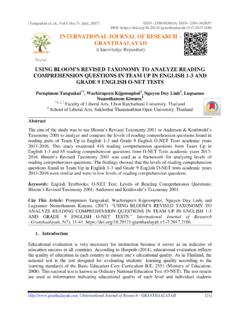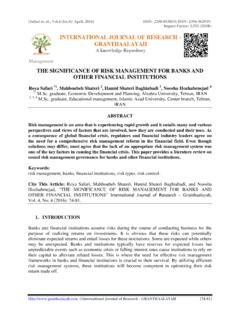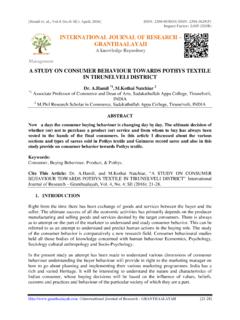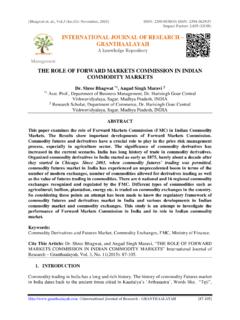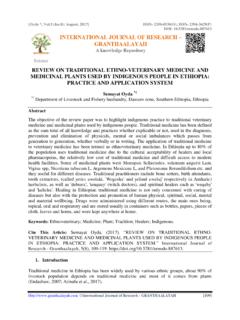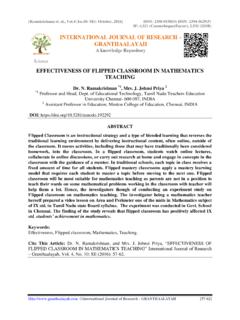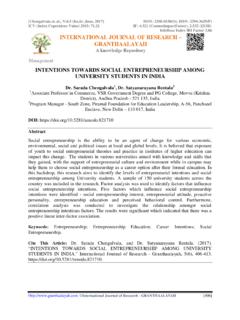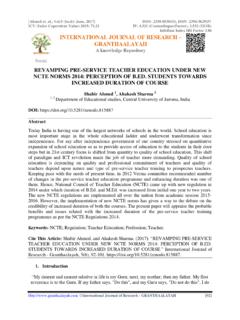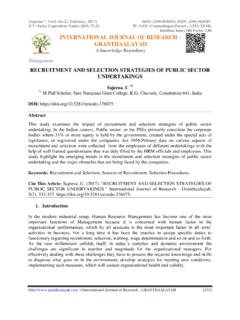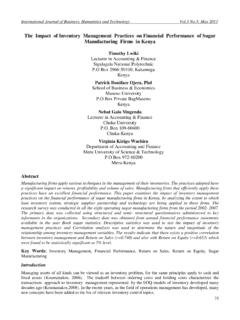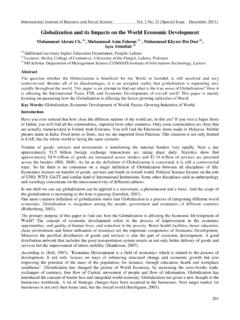Transcription of INTERNATIONAL JOURNAL of RESEARCH …
1 [Shahriari , ( ):April,2015] ISSN- 2350-0530(O) ISSN- 2394-3629(P) Management INTERNATIONAL JOURNAL of RESEARCH GRANTHAALAYAH A knowledge Repository INTERNATIONAL JOURNAL of RESEARCH -GRANTHAALAYAH [49-55] E-COMMERCE AND IT IMPACTS ON GLOBAL TREND AND MARKET Shahrzad Shahriari* 1, Mohammadreza Shahriari2, Saeid gheiji3 *1 University College of Commerce & business Management Osmania University, Hyderabad, INDIA 2 University College of Commerce & business Management Osmania University, Hyderabad, INDIA 3 Gorgan Saee higher education institute, Gorgan Branch, Gorgan, IRAN *Correspondence Author: Abstract: Many economists and experts believe that in recent years, a revolution has occurred similar to the industrial revolution which the world has entered the information age. It makes large changes in the economic, social and cultural aspects.
2 One aspect of this transformation is changes in economic relations between individuals, corporations and governments. Commercial exchange between people who had been based on paper documents to transactions of by us the systems based on electronic information. In this article we will discuss the benefits of e-commerce and its impact on the market. Keywords: E-Commerce, advantage, needs, global, impact. Cite This Article: Shahrzad Shahriari, Mohammadreza Shahriari, and Saeid gheiji, E-Commerce and It Impacts on Global Trend and Market. INTERNATIONAL JOURNAL of RESEARCH Granthaalayah, Vol. 3, No. 4(2015): 49-55. 1. INTRODUCTION E-commerce has so many advantages in our life because it makes convenient in daily life of the people. Several explanations have been proposed for e-commerce that most of them are based on past experiences in the use of e-commerce.
3 As with e-commerce, e- business also has a number of different definitions and is used in a number of different contexts. One of the first to use the term was IBM, in October 1997, when it launched a campaign built around e- business . Today, major corporations are rethinking their businesses in terms of the Internet and its new culture and capabilities and this is what some see as e- business . There is no one commonly agreed definition of e-commerce or e- business . Thus, there is a need to clarify terms being used and explain the context in which they are being applied. E-commerce has an impact on three major stakeholders, namely society, organizations and customers. There are a number of advantages, which include cost savings, increased efficiency, customization and global marketplaces. There are also limitations arising from e-commerce which apply to each of the stakeholders.
4 In order to understand electronic commerce it is important to identify the different terms that are used, and to assess their origin and usage. These include information overload, reliability and security issues, and cost of access, social divisions and difficulties in policing the Internet. Successful e-[Shahriari , ( ):April,2015] ISSN- 2350-0530(O) ISSN- 2394-3629(P) Management INTERNATIONAL JOURNAL of RESEARCH GRANTHAALAYAH A knowledge Repository INTERNATIONAL JOURNAL of RESEARCH -GRANTHAALAYAH [49-55] commerce involves understanding the limitations and minimizing the negative impact while at the same time maximizing the benefits-commerce businesses usually employ some or all of the following practices: Provide detail of virtual storefront on websites with online catalogs, sometimes gathered into a "virtual mall" Buy or sell on online marketplaces.
5 Gather and use demographic data through web contacts and social media. Use electronic data interchange, the business -to- business exchange of data. Reach prospective and established customers by e-mail or fax (for example, with newsletters). Use business -to- business buying and selling. Provide secure business transactions. Engage in retail for launching new products and services 2. WHAT IS THE E-COMMERCE? Electronic commerce, commonly known as E-commerce, is trading in products or services using computer networks, such as the Internet. Electronic commerce draws on technologies such as mobile commerce, electronic funds transfer, supply chain management, Internet marketing, online transaction processing, electronic data interchange (EDI), inventory management systems, and automated data collection systems. Modern electronic commerce typically uses the World Wide Web for at least one part of the transaction's life cycle, although it may also use other technologies such as e-mail.
6 In the simplest case, it can be defined as doing business transactions in an electronic format. The European Commission has defined the e-commerce in 1977 as follow: The April 1997 edition (ERCIM News No. 29) reported that "Europe has been lagging with respect to the rest of the world in its way towards the information society". As far as electronic commerce is concerned there is strong activity developing and a focus that is specifically European is certainly arising. This is happening on three fronts - firstly there is serious use of electronic commerce in many European countries, including France, The Netherlands, Sweden and the UK; secondly, these national activities are being brought together through a new user body, Electronic Commerce Europe (ECE); thirdly the European Commission is bringing together its various actions under a co-operative umbrella and calling for serious implementation initiatives under the latest ESPRIT Thematic Calls.
7 E-commerce based on data processing, including text, sound, image. The business includes various activities such as the electronic exchange of goods and services, instant delivery of digital content, business plans, collaborative design and engineering, electronic stock exchange, government procurement, direct marketing, services after the sales. E-commerce is the buying and selling of goods and services, or the transmitting of funds or data, over an electronic network, primarily the Internet. These business transactions occurs business -to- business , business -to-consumer, consumer-to-consumer or consumer-to- business . The terms e-commerce and e- business are often used interchangeably. The term e-tail is also sometimes used in [Shahriari , ( ):April,2015] ISSN- 2350-0530(O) ISSN- 2394-3629(P) Management INTERNATIONAL JOURNAL of RESEARCH GRANTHAALAYAH A knowledge Repository INTERNATIONAL JOURNAL of RESEARCH -GRANTHAALAYAH [49-55] reference to transactional processes around online retail.
8 E-commerce is conducted using a variety of applications, such as email, fax, online catalogs and shopping carts, Electronic Data Interchange (EDI), File Transfer Protocol, and Web services. Most of this is business -to- business , with some companies attempting to use email and fax for unsolicited ads (usually viewed as spam) to consumers and other business prospects, as well as to send out e-newsletters to subscribers [1; 6]. 3. GLOBAL TRENDS In 2010, the United Kingdom had the biggest e-commerce market in the world when measured by the amount spent per capita. The Czech Republic is the European country where ecommerce delivers the biggest contribution to the enterprises total revenue. Almost a quarter (24%) of the country s total turnover is generated via the online channel. Among emerging economies, China's e-commerce presence continues to expand every year.
9 With 384 million internet users, China's online shopping sales rose to $ billion in 2009 and one of the reasons behind the huge growth has been the improved trust level for shoppers. The Chinese retailers have been able to help consumers feel more comfortable shopping online. China's cross-border e-commerce is also growing rapidly. E-commerce transactions between China and other countries increased 32% to trillion yuan ($ billion) in 2012 and accounted for of China's total INTERNATIONAL trade in 2013, Alibaba had an e-commerce market share of 80% in China. Brazil s ecommerce is growing quickly with retail ecommerce sales expected to grow at a healthy double-digit pace through 2014. By 2016, eMarketer expects retail ecommerce sales in Brazil to reach $ billion. India s ecommerce growth, on the other hand, has been slower although the country's potential remains solid considering its surging economy, the rapid growth of internet penetration, English language proficiency and a vast market of billion consumers although perhaps only 50 million access the internet through PCs and some estimate the most active group of e-commerce customers numbers only 2-3 million.
10 E-commerce traffic grew about 50% from 2011 to 2012, from million to million, according to a report released by Com Score. Still much of the estimated 14 billion dollars in 2012 ecommerce was generated from travel sites [7; 8]. E-Commerce has become an important tool for small and large businesses worldwide, not only to sell to customers, but also to engage them. In 2012, ecommerce sales topped $1 trillion for the first time in history. 4. IMPACT ON MARKETS AND RETAILERS Economists have theorized that e-commerce ought to lead to intensified price competition, as it increases consumers' ability to gather information about products and prices. RESEARCH by four economists at the University of Chicago has found that the growth of online shopping has also affected industry structure in two areas that have seen significant growth in e-commerce, bookshops and travel agencies. Generally, larger firms are able to use economies of scale and offer lower prices.
